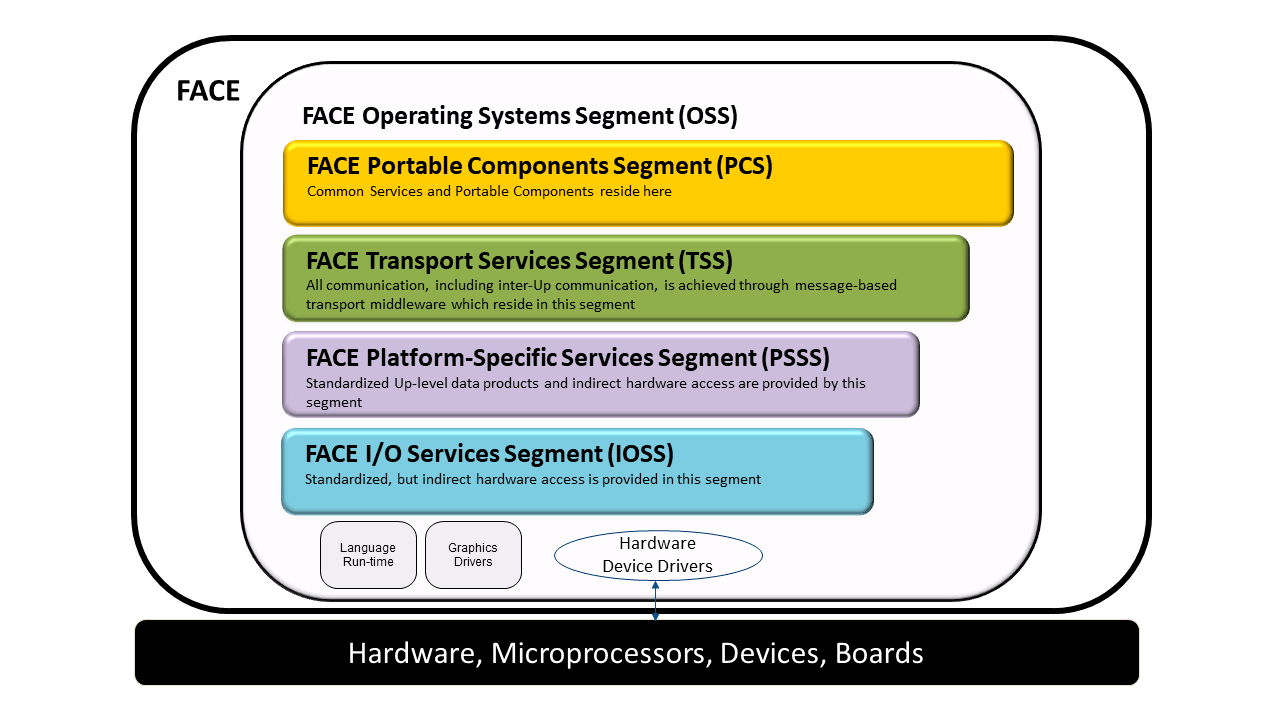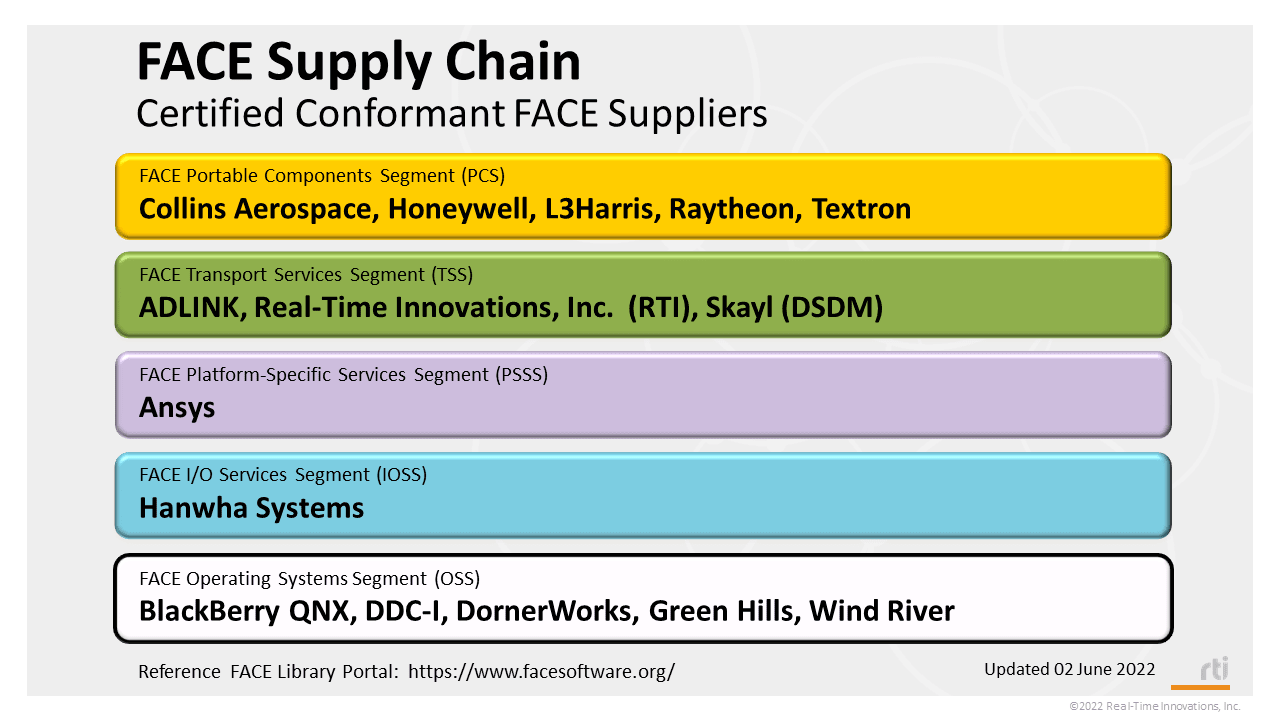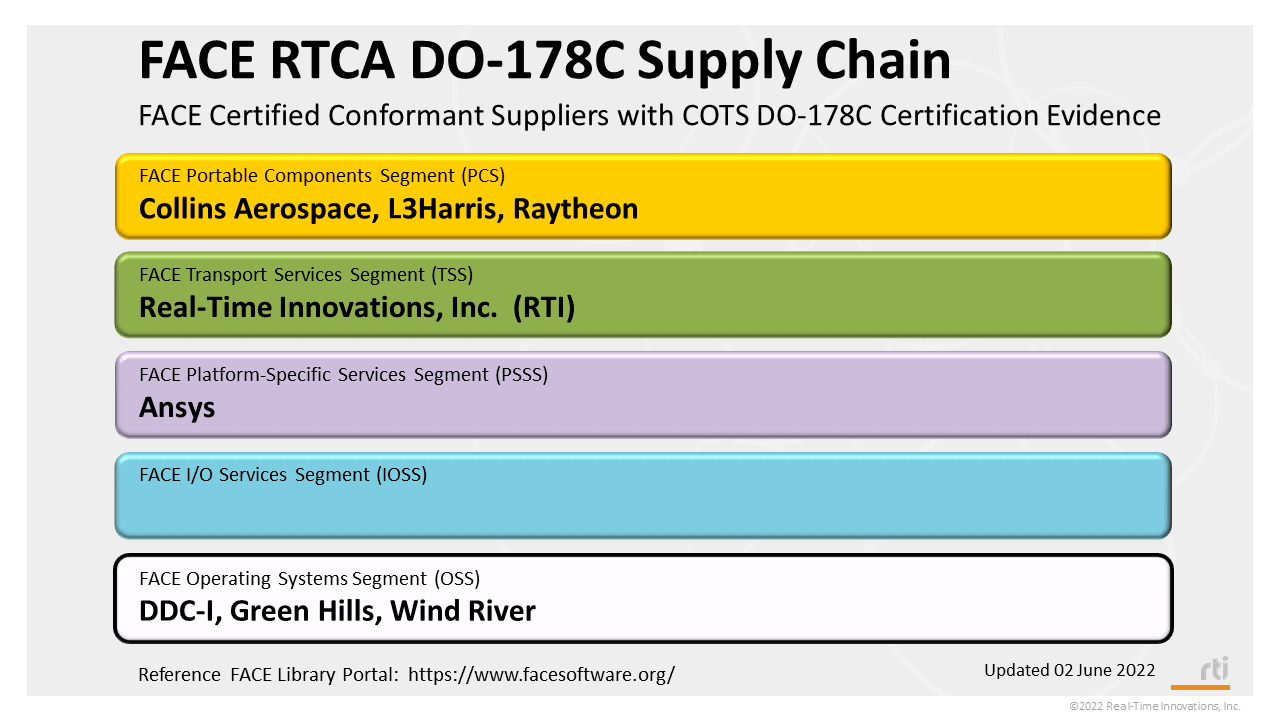5 min read
Leveraging Commercial Avionics Standards: Understanding the FACE Reference Architecture
 Chip Downing
:
August 9, 2022
Chip Downing
:
August 9, 2022

Part 3 of the RTI Military Avionics Blog Series
In my previous two blog posts, I discussed the ARINC 6531 standard and the DO-297 roles and responsibilities for delivering software into an integrated modular avionics (IMA) environment, including both commercial and military/FACE™ avionics systems. This third blog post focuses on one of the most expensive aspects of airborne software – airworthiness and safety certification, and how the use of common avionics standards provides efficiencies for both commercial and military programs.
The global commercial avionics industry has required the use of the RTCA DO-1782 standard for over three decades, with an excellent record of aircraft safety using this standard. On the other hand, military avionics have used a range of standards over the years, including MIL-STD-882, MIL-STD-516, AR-70-62, and more, but these standards have never had a wide following or a competitive supplier ecosystem that supports these older military avionics safety standards.
This landscape is now changing. Over the past few years, more military air systems programs are now transitioning to the DO-178C standard, and this trend is starting to reduce cost and risk, increase quality, and shorten time-to-deployment for new airborne technologies.
To recap this evolution, the DO-178C transition started with the Future Airborne Capability Environment (FACE) Consortium and the joint efforts of over 100 companies and 2,000 individuals to define a technical standard and business approach that can reduce cost and increase capabilities in military avionics systems.
The FACE Technical Standard3 is a standard-of-standards, referencing over 60 open standards, and is based upon a layered software architecture designed for rapidly replacing any software component as required. These layers, or FACE segments, consist of a software component or domain-specific data model designed to meet the applicable requirements defined in the FACE Technical Standard for a defined FACE architectural segment. These software modules are referenced as a FACE Unit of Conformance (UoC).
The FACE Reference Architecture defines a set of standardized interfaces that provide connections between the five FACE architectural segments. These segments are:
- Operating System Segment (OSS). The FACE OSS is where foundational system services and vendor-supplied software reside. An OSS Unit of Conformance (UoC) provides and controls access to the computing platform.
- Input/Output Services Segment (IOSS). The IOSS is where normalization of vendor-supplied interface hardware device drivers occurs. IOSS UoCs provide the abstraction of the interface hardware and drivers from the PSSS UoCs.
- Platform-Specific Services Segment (PSSS). The PSSS is composed of sub-segments available in a given airborne platform, including Platform-Specific Device Services, Platform-Specific Common and Graphics Services.
- Transport Services Segment (TSS). The TSS consists of communication services. The TSS abstracts transport mechanisms and data access from software components, facilitating integration into disparate architectures and platforms using different transports.
- Portable Components Segment (PCS). The PCS is the application layer, and it is composed of software components that provide capabilities and/or business logic. PCS components are intended to remain agnostic from hardware and sensors and are not tied to any data transport or operating system implementations, which allow these components to meet the objectives of portability and interoperability.

Figure 1. The Five Segments of the FACE Reference Architecture
To increase quality and reduce integration time, the FACE Consortium also created a UoC conformance and certification program, called the FACE Conformance Program. This is a process whereby UoCs are independently evaluated against a rigorous FACE Conformance Test Suite. Once independently verified by a FACE Verification Authority (VA), then certified by a FACE Certification Authority (CA) that a given UoC supports all requirements, this software component then becomes a FACE Certified Conformant UoC. The last step in the FACE Conformance Program is the FACE Registry, which allows the software supplier to publicly disclose and advertise a FACE Certified Conformant UoC(s).
Building a conformance program also enabled the creation of a FACE Registry, in which systems designers and program managers can find descriptions of each FACE Certified Conformant product. Please refer to Figure 2 below for the current list as of the date of publication of this blog post.
Note that not all FACE Certified Conformant software capabilities are listed in the FACE Registry in the FACE Library Portal. Many, if not most, of these applications deliver a highly competitive military advantage over global adversaries, so listing these software solutions on a public website would be highly inappropriate. With this in mind, the FACE Registry understates the success of the FACE Technical Standard and Business Approach.

Figure 2. FACE Certified Conformant Suppliers (as of 9 August, 2022).
Government / Industry Adoption
The U.S. Armed Services are now moving in the direction of enabling military airworthiness certifications to adopt the RTCA DO-178C avionics software safety standard, already proven in hundreds of commercial aircraft. This move produced an unexpected efficiency by creating commercial-off-the-shelf (COTS) certification evidence that can be used in multiple programs and platforms, minimizing the cost for each program, versus the legacy approach of creating safety artifacts for a single platform with one program absorbing all of the costs. The FACE approach therefore not only creates technology-leading software that can be more readily deployed, but also enables COTS safety certification evidence proven on other platforms to be re-used in order to accelerate time to airworthiness and deployment.
Therefore, the FACE layered architecture can be directly mapped to industry partners delivering not only Certified FACE Conformant software, but also commercial DO-178C certification evidence, as depicted in Figure 3. Note that Blackberry QNX has ISO 26262 ASIL D autonomous automobile certification evidence that is similar, but not quite as rigorous as DO-178C.

Figure 3. FACE Certified Conformant Suppliers with DO-178C Certification Evidence (as of 9 August, 2022).
Now, military avionics designers can procure FACE software products from an open market and also procure relevant safety evidence. The advantage of having both companion products available is driving a new marketplace that lowers the cost of acquisition and accelerates the time-to-airworthiness and deployment for both commercial and military avionics systems.
The FACE Technical Standard and Business Approach drives new efficiencies and readiness in next-generation avionics systems. It is also driving complementary and parallel benefits that are not part of the FACE effort, creating a halo effect for both government and industry. This approach has two key advantages:
- It is true that the FACE Technical Standard does not specify certain airworthiness standards that must be used in FACE Certified Conformant components. However, because these components are based upon both commercial and military standards, each industry can provide proven and affordable RTCA DO-178C certification evidence for their certified conformant products. This increases the marketplace for commercial safety certification investments and reduces both cost and time to deployment for military programs, while vastly reducing risk.
- Having government, industry and academia participate collaboratively in solving competitive challenges for military avionics opens the door to greater participation by a larger number of experts in defining best practices and creating affordable avionics solutions. This completely upends traditional procurement roles and business silos, enabling very deep and highly responsive supply chain relationships to be built. This collaborative environment drives higher quality and more competitive capabilities to the warfighter faster.
Conclusion
In today’s world, with a growing number of peer and near-peer adversaries, maintaining strategic dominance requires a focused effort from both government and industry, requiring all parties to adapt and evolve to meet new challenges head-on. Adopting both commercial standards and the FACE Technical Standard and Business Approach has been proven to accelerate the inclusion of the latest airborne innovations. In addition, this shift has created the parallel benefits discussed above, such as increasing quality, removing program risk factors, and accelerating time-to-airworthiness and deployment. These factors can help avionics manufacturers stay ahead of both fierce competition and potential adversaries.
Please read Part 4 in the RTI Military Avionics Blog Series here.
Footnotes -
1ARINC 653 Avionics Application Software Standard, published by SAE International, August 2015, https://www.sae.org/standards/content/arinc653p1-4/
2RTCA DO-178C, Software Considerations in Airborne Systems and Equipment Certification”, December 2011, https://my.rtca.org/NC__Product?id=a1B36000001IcmrEAC
3FACE™ Technical Standard, Edition 3.1 (C207), published by The Open Group, July 2020; refer to: www.opengroup.org/library/c207
About the author
 Chip Downing is Senior Market Development Director, Aerospace & Defense, Real-Time Innovations, Inc.
Chip Downing is Senior Market Development Director, Aerospace & Defense, Real-Time Innovations, Inc.
Chair, FACE Business Working Group Outreach Subcommittee
Posts by Tag
- Developers/Engineer (180)
- Technology (79)
- Connext Suite (77)
- News & Events (75)
- 2020 (54)
- Aerospace & Defense (52)
- Standards & Consortia (51)
- Automotive (38)
- 2023 (34)
- 2022 (29)
- IIoT (27)
- 2025 (25)
- Leadership (24)
- Healthcare (23)
- 2024 (22)
- Connectivity Technology (21)
- Cybersecurity (20)
- 2021 (18)
- Culture & Careers (15)
- Military Avionics (15)
- FACE (13)
- Connext Pro (10)
- JADC2 (10)
- ROS 2 (10)
- Connext Tools (7)
- Connext Micro (6)
- Databus (6)
- Transportation (5)
- Case + Code (4)
- Connext (4)
- Connext Cert (4)
- Energy Systems (4)
- FACE Technical Standard (4)
- AI (3)
- Oil & Gas (3)
- Research (3)
- Robotics (3)
- #A&D (2)
- Connext Conference (2)
- Edge Computing (2)
- Golden Dome (2)
- MDO (2)
- MS&T (2)
- RTI Labs (2)
- TSN (2)
- ABMS (1)
- C4ISR (1)
- DOD (1)
- ISO 26262 (1)
- L3Harris (1)
- LabView (1)
- MOSA (1)
- MathWorks (1)
- National Instruments (1)
- Simulation (1)
- Tech Talks (1)
- UAM (1)
- Videos (1)
- eVTOL (1)
 Success-Plan Services
Success-Plan Services